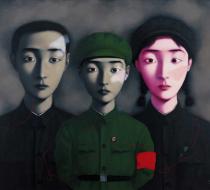Bloodline: Big Family Favorite
The immediate prototypes of Zhang Xiaogang’s Big Family series are formal group photographic portraits from the 1950’s and 60’s, including those of Zhang’s own family, a source of the painter’s “endless reveries.” From these old black-and-white pictures Zhang Xiaogang derived the series’ paradigmatic features: a subdued, nearly monochromatic palette; a thickly layered but flat surface, without overt evidence of brushwork; a general compositional restriction to upper bodies; the rigid and frontal poses and faces; and of course the Mao-era hairstyles and dress. The off-color passages, first introduced as patches of light on the faces, later became independent surface elements that recall damaged photographs. Given the series’ origin in the genre of the family portrait, it has become customary to attribute its success to the importance of the concept of family in Chinese culture. The critic and dealer Johnson Chang has written, for example, “Through the Chinese tradition of portraiture, Zhang has drawn upon the classical iconography of ancestor portraiture of which every Chinese would have vague collective memory of.” Likewise, for Li Xianting, “The legacy of Confucian ethics takes visual form in the common Chinese family’s ‘family group’ photographs. The technique of formal retouching, the classical upright pose of the figures, the rigidly set social order: all reveal the enduring power of the blood relationship.”
But the families Zhang Xiaogang paints have a historical specificity that the labels “Chinese” and “Confucian” do not quite capture. Despite the series’ title, none of these families is in fact “big”; never once do more than two generations or more than a handful of individuals share the same canvas, whereas portraits of extended families, with grandparents and grandchildren huddled together, were in fact very common. Although the red lines that connect Zhang’s family members often extend to the edges of the canvases, and although infant genitalia are recurring motifs, these intimations of a lineage continuing beyond the frame are ultimately subservient to an image of the nuclear family, which is not so much traditional or Confucian as distinctly modern. The preponderance of the single child, almost always centered and preternaturally self-conscious like the infant Christ in European pictures, has reminded more than one critic of China’s One-child Policy, introduced in 1978. Karen Smith writes of these works, “Conjuring allusions to received impressions of China under Mao and through the Cultural Revolution, [the Big Family paintings] are eloquently, poignantly, Chinese in their sensibilities. Since the format is derived from conventional black and white, occasionally handcoloured photographic snapshots of the proletariat post-1949, these are sensibilities that Zhang Xiaogang renders accessible to all.” Also referring to the People’s Republic, the historian Joseph Esherick writes of the “reconstitution of the family as a nuclear family with a husband-wife pair and their children. The spousal bond became more important than ever, though it was often tested in the turmoil of political campaigns.”
Through his expansive clan of replica characters, Xiaogang questions notions of otherness, difference, and perception. In Bloodline, Xiaogang’s two sitters stare out from the canvas with piercing neutrality, confronting the viewer with an alien gaze worthy of their own unnatural presence; the Asian conception of oneness a stark contrast to the western value of individuality. In this portrait, a father and daughter are represented with perturbing similarity, their expressionless androgyny giving them a futuristic air of superiority that can be read as either spiritual enlightenment or malice.
Xiaogang’s figures, with their same-same appearance and expression, allude to a disturbing mass psychology. In My Dream: Little General Xiaogang’s image of a boy, dressed in military uniform and naked from the waist down, exemplifies the anxiety between public veneer and private vulnerability, official doctrine and personal conscience. Rendered with a patina aura, Xiaogang’s painting is both dreary and heroic, encapsulating the optimism of a bygone era and its hind-sight failures; the child a nostalgic emblem of corrupted innocence, trapped between the romantic aspiration of the model citizen ideal and its unattainable reality.









